This is part of an ongoing series of blog posts by students of the V&A/RCA History of Design MA programme, composed to accompany the ‘Building the Royal Albert Hall’ display on view at the V&A in Room 127 (the entrance to the Architecture Gallery) until 7 January 2018. Here second-year student Karen Morton discusses changing fashions in the design of the private boxes at the Hall.
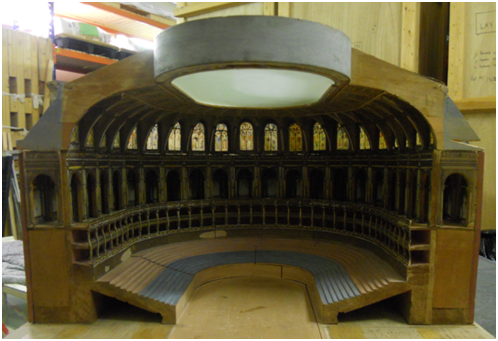
As seen in this model for the interior design of the Hall, the boxes were arranged in tiers and formed a three dimensional surface requiring decoration. It appears that Scott had designed the tiers of boxes finished in lighter colouring with the intention of creating a backdrop to the display of ladies’ dresses. His views contrasted with those of Cole who preferred the box-fronts coloured brown and possibly with a decorative treatment which had the appearance of ‘marquetry’ (inlaid wood).
The construction of the Royal Albert Hall was partially funded by private investors buying boxes for a hundred pounds each, with two of the first purchasers being Queen Victoria and the Prince of Wales. It is interesting to note that although the exterior of the boxes presented a uniform decorative treatment decided by the committee, individuals were allowed to decorate the box interiors in their own taste, possibly as an expression of ownership and reinforcing their attachment to the Royal Albert Hall, thus encouraging frequent visits. Choice of decoration could be interpreted in some boxes as a cosy extension of the home and in others as a place in which to escape to a luxurious environment. The variety of styles that ensued gave rise to some comment:
The Times 27 March 1871 reported:
The boxes are all carpeted with green carpet and furnished with crimson curtains…. But beyond this the decoration and furnishing of each box are left to the proprietor. Many of them are being hung with variegated chintz, and the numerous patterns already displayed give a sort of patchwork appearance which will, it may be hoped, be in great measure concealed by curtains and audience.
The Morning Post 30 March 1871:
In the boxes on each side of her Majesty’s, an exterior view of crimson hangings is all that can be seen, and a closer inspection shows that the walls are not yet touched. The owners of these boxes are allowed the widest latitude as regards the interior adornment of their property, and, it is hoped, will exercise due aesthetic taste when they begin their decorations. Some of the hangings are of cherry red with a chintz lining, and the luxurious taste of one gentleman or lady has led to one box being padded with crimson satin.
These vivid descriptions help us to imagine a picture of the boxes as places of comfort that their owners would enjoy when visiting the Hall and in some cases a sense of ‘home from home,’ whilst in others they seem to have offered an almost fantasy environment in which to enjoy the show.
The Royal boxes are described in The Morning Post 30 March 1871:
In the Queen’s box decorations are chiefly of white and gold. On the panels of the door and the walls are figures and other paintings of an arabesque character, with plaques – also a feature of the retiring rooms devoted to the use of the Queen and the Prince of Wales. The crimson fringe, the gold patra, and the turquoise-blue decorations make her Majesty’s box artistically pleasing to the vision, whilst the crimson drapery is in harmony with all. The other Royal Box [belonging to the Prince of Wales] is somewhat similarly decorated. The fronts of the boxes show a crimson edging, studded with gold headed nails; the curtain poles are gold-coloured, and in the orchestra the railings are of the same glittering hue.
There is little pictorial evidence of the box interiors during the Victorian era, however contrasting tastes in decoration during the twentieth century between the 1950s and the 1980s can be seen in Royal Albert Hall archive photographs and reflect key elements of British domestic interior design of the times. In the first half of the twentieth century there was a preference at all levels of society for an ambience of comfort distinguished by a copious use of textiles as curtains, rugs, soft furnishings and padded upholstery. Photographs of the earlier box interiors of the 1950s show a prevailing preference for chintz upholstery and comfortable armchairs, redolent of the ‘country cottage’ style which had continued in popularity since the Arts and Crafts movement earlier in the century, possibly as a reassuring emblem of more stable times prior to the two world wars.
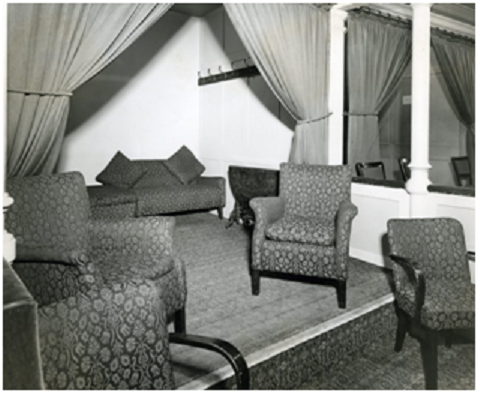
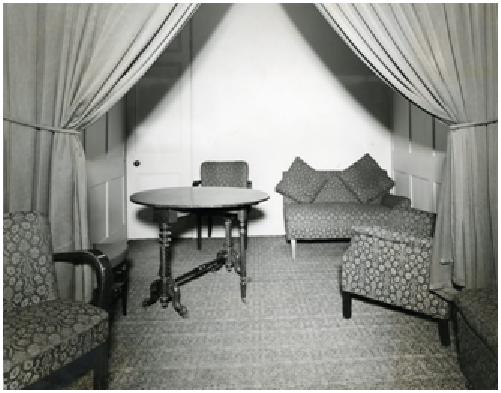
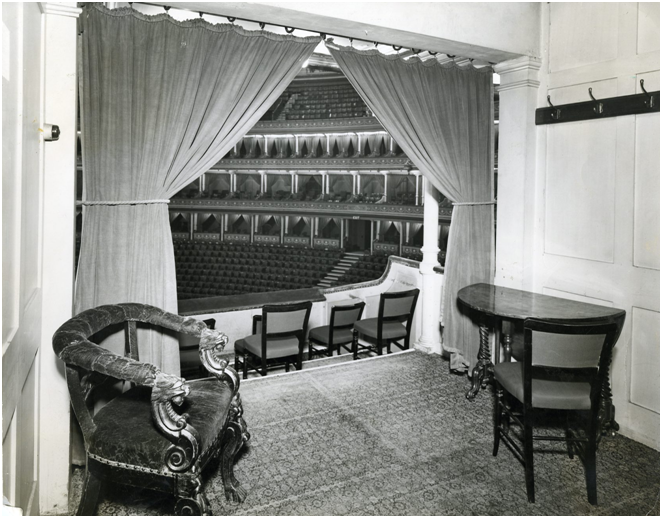
Thirty years later the furniture had a more streamlined and uniform effect, yet where upholstery was used we can see a return to the use of plain red velvet, favoured when the Royal Albert Hall first opened. In the 1980s upholstery receded as a main decorative feature and the decor met the minimum requirements for comfort, with increased use of hard materials, such as tubular steel, reflecting a style with a more lightweight silhouette and uncluttered appearance.
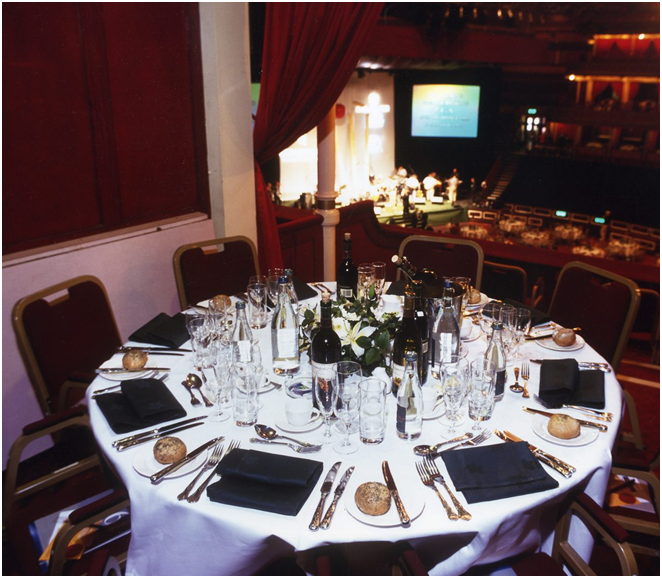
Formal dining in a Grand Tier box, 1980s
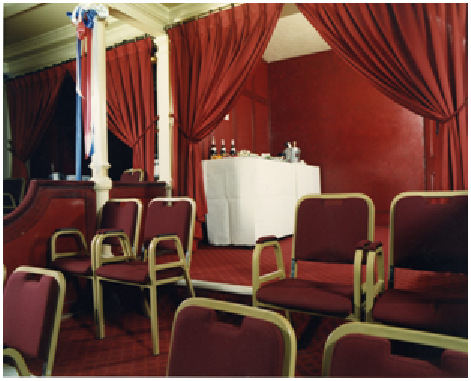
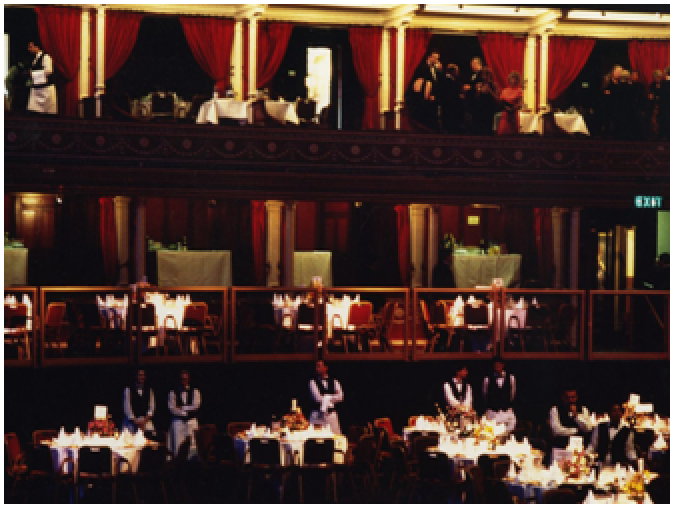
With thanks to Elizabeth Harper Archive Manager and her colleagues at The Royal Albert Hall Archives
To see what else V&A/RCA History of Design students and alumni have been up to, check our pages on the V&A and RCA websites and take a look at Un-Making Things, a student-run online platform for all things design history and material culture.
Further Reading:


